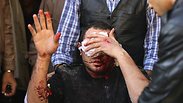
Egypt's first official inquiry into last summer's deadly crackdown on supporters of the country's ousted Islamist president blamed security forces Wednesday for disproportionate use of gunfire to break up protests, yet it accused gunmen inside the protest of shooting at police, escalating violence that killed hundreds of civilians.
The report by the government-appointed National Council for Human Rights investigated the events of Aug. 14, when troops moved in on the weeklong sit-in held by Mohammed Morsi supporters. The report offers a rare official criticism of the Egyptian security agencies' excessive use of force, abuses already alleged by international rights groups.
The National Council divided the blame for the bloody crackdown, however, alleging that the high civilian body count was partially due to protest organizers allowing gunmen into their midst. The report also blamed protesters for sparking the violence, alleging that they shot from inside a mosque and killed a police officer who had been using a megaphone to call on protesters to evacuate.
Related Stories:
- Egyptian troops clear pro-Morsi sit-ins; Brotherhood says 500 killed
- Egypt: Pro-Morsi protesters retake Tahrir square, clash with police
"While the security force had the necessary reasons to use firearms ... it failed to maintain self-restraint at times, and proportionality in the intensity of (its) gunfire," said council member Nasser Amin, reading the report's conclusions at a news conference. "The security forces had identified a safe corridor for the protesters to use ... but they failed to secure it" until after the clashes subsided, referring to evacuation routes the troops urged protesters to take.
The total death toll at the site was 624 civilians and eight police officers, the council said, citing forensic reports. Most rights groups have used similar numbers, although Morsi supporters insist the toll is much higher. International groups also had recognized that there were armed men among the protesters, but reported that the security forces used unnecessary force to disperse the sit-ins.
The dispersal came weeks after Morsi was overthrown by the military following days of mass protests against him. Morsi supporters refused to accept his ouster, setting up two protest camps in Cairo -- one outside the Rabaah al-Adawiya mosque and another outside Cairo University.
The Rabaah protest camp was the largest, and was used by the leadership of Morsi's Muslim Brotherhood to rally supporters. Local residents complained the camp obstructed access to their homes, and many reported incidents of abuse by the protesters. The council said forensics teams had documented 11 cases of deadly torture around the two protest camps.
Security forces moved in on the two camps early in the morning after repeatedly urging them to disperse, and the dispersal was televised live. Mohammed ElBaradei, a democracy advocate who was interim vice president at the time, resigned in protest over the violence. Then-Prime Minister Hazem el-Beblawi said he regretted the bloodshed, though he offered no apologies for moving against the camps, saying protesters were given ample warnings to leave and that he had tried foreign mediation efforts.
Since the dispersal, authorities have arrested thousands of Morsi supporters and regularly break up their demonstrations, which often descend into violence. Morsi himself remains in detention and faces a number of charges, including incitement to murder and conspiring with foreign groups.
The report said the dispersal sparked wider violence in the days that followed, when suspected Morsi supporters torched churches and attacked police stations. It said those attacks killed 686 people, including 64 police officers.
The council's final report will be issued in two weeks, Amin said. In the presentation Wednesday, videos obtained by the council from witnesses showed gunmen running around inside the protest camps. Other videos showed gunmen in civilian clothes, but it was not immediately possible to ascertain their identity and whether they were inside the camps or nearby. The presentation, however, showed no videos of use of excessive force by security forces.
Although an official body, the council failed to gain access to interior ministry's plans on how to disperse the encampments, Amin said.
Gamal Eid, an independent human rights activist, said the report was "bestowing legitimacy" on the crackdown by dividing the blame on both sides. He said the council recommended further investigation instead of assigning blame. "it compares between the security forces who lost eight people, and the protesters who lost 624. This is misleading," Eid said. "Regrettably, state human rights bodies act to beautify the image of governments."















